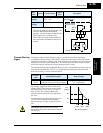
SJ300 Inverter
Operations
and Monitoring
4–55
Thermal Warning
Signal
The purpose of the electronic thermal setting is to protect the motor from overloading,
overheating and being damaged. The setting is based on the rated motor current. The inverter
calculates the thermal rise (heating) of the motor using the current output to the motor squared,
integrated over the time spent at those levels. This feature allows the motor to draw excessive
current for relatively short periods of time, allowing time for cooling.
The Thermal Warning output [THM] turns ON to provide a warning before the inverter trips for
electronic thermal protection. You can set a unique thermal protection level for each of the
three motor profiles, as shown in the table below.
For example, suppose you have inverter model
SJ300-110LFE. The rated motor current is 46A.
The setting range is (0.2 * 46) to (1.2 *46), or
9.2A to 55.2A. For a setting of B012=46A
(current at 100%), the figure to the right shows
the curve.
The electronic thermal characteristic adjusts the
way the inverter calculates thermal heating,
based on the type of torque control the inverter
uses.
CAUTION: When the motor runs at lower
speeds, the cooling effect of the motor’s internal
fan decreases.
Valid for
outputs:
11, 12, 13, 14, 15,
AL0 – AL2
Required
settings:
B034
Notes:
• The two outputs [RNT] and [ONT] share the
same time threshold parameter, B040.
Typically, you will use either the [RNT] or the
[ONT] output only—not both at once.
• These outputs are useful for the notification
that a preventative maintenance interval has
expired.
Opt.
Code
Symbol Function Name
Output
State
Description
CM2
1314
15
11
12
See I/O specs on page 4–9.
Inverter output
terminal circuit
Example: (Requires output configuration—
see page 3–53
.)
RY
+
–
RNT or
ONT
Function
Code
Function/Description Data or Range
B012 / B212
/ B312
Electronic thermal setting (calculated
within the inverter from current output)
Range is 0.2 * rated current to
1.2 * rated current
Tr ip
time (s)
Trip current at 60 Hz
60
0.5
0
53.4 69 92
A
116% 150% 200%


















